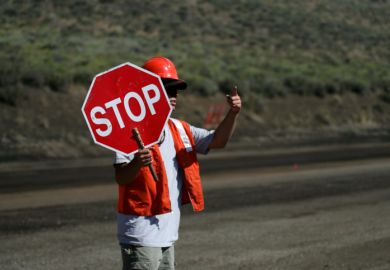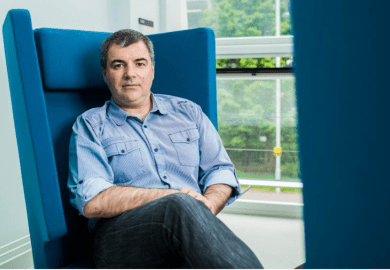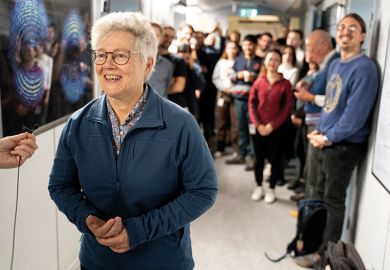Is anything impossible? All of us have dreamt about the frontiers of the human imagination. Could we travel back in time? We might avoid our past mistakes, win a crucial football match, encounter that elusive person. Could we attain perpetual youth, never to age or be sick? Do fairies exist? Our most extravagant wishes could be granted, if only we could find the right key. Writers, composers and film directors have long explored these themes. The journey continues from H. G. Wells to Leoš Janácek, from Dorian Gray to Superman, from Groundhog Day to Back to the Future, and from Peter Pan to Tolkien's elves.
What may surprise many is that physics entertains all these possibilities and more. The Arthurian theme from T. H. White that "everything not forbidden is compulsory" provides a happy hunting ground in Michio Kaku's new book, Physics of the Impossible: A Scientific Exploration into the World of Phasers, Force Fields, Teleportation, and Time Travel.
Take time travel as a desirable goal for many of us. We all regret past errors. What would we not give to have another chance to revisit that brief encounter with a person never seen since or to retake that crucial examination? Or for those who are bored by modern tourism opportunities, why not a photographic safari for Tyrannosaurus rex in situ, or a walking tour of the original Seven Wonders of the World? Physics says all of this and more is possible. Not today, nor tomorrow, but such adventures lie within the explorable bounds of physics.
Here is the recipe: construct a wormhole. This bizarre object, predicted to exist in Einstein's theory of gravitation, is a tunnel through space and time. It is accessed only through a black hole, so no return is possible without violating the laws of physics. Quantum gravity, the ultimate theory that unites gravity and quantum theory, and which is the holy grail of particle physics today, actually requires that both tiny black holes and wormholes must exist throughout space. However, their lifetime is fleeting, and they disappear before we can capture or even detect one. The vacuum is thought to be teeming with such brief-lived oddities. Wormholes are there to be trapped, if we only knew how.
However, the trapping can be done without violating physical laws. It merely requires developing a very stiff material that resists gravity. Such a material is even found in highly dilute form: we call this the dark energy that is responsible for the observed acceleration of the universe. Time machine technology would require us to harness this force, use it to prop open a wormhole before it closes up, and scale this up to the point at which the intrepid time traveller could jump in and vanish from visibility. She would end up, if she survived the journey, in a new region of space and time.
This type of time travel is our best bet for exploration but is far out from any technology we can presently imagine. Kaku classifies this as Type II technology, achievable in perhaps a million years without violating any of our cherished concepts. Fairies? Well, they could exist in a parallel universe, given that anything possible must exist somewhere if there are an infinite number of universes to populate. There are incalculable numbers of pocket universes in our metaverse. With an infinite number of possibilities, anything goes. Unfortunately, physically accessing a parallel universe would require fundamental changes in our understanding of physics. Such a discovery is not impossible, and Kaku labels this Type III technology, accessible no sooner than a billion years in the future.
Some seeming impossibilities are achievable in the near future. One example is invisibility. H. G. Wells speculated about the Invisible Man, but we have since developed stealth technology that renders aircraft invisible to radar. To make them optically invisible requires a giant leap forward, but one that is perfectly feasible. It requires the emerging technology of transparent metamaterials, which can bend light by modifying the index of refraction. Cutting-edge nanotechnology is needed, since we need to manipulate atoms on scales smaller than the wavelength of light. But there is no reason in principle that such a goal could not be achieved within the next decade or two.
Humanity has possessed advanced technology for less than a century. Progress has been staggering. We have entered the realm of what the ancient Greeks ascribed to the gods. We have mastered flying machines and space travel, achieved almost instantaneous video communication at vast distances and controlled explosions of virtually unlimited power.
Imagine what we might be capable of achieving in a century, in a thousand years or in a million years. It would be a rash person who stated that our knowledge of physics precluded our being able to master a time machine.
Of course there always have been established scientists, who are as liable to error as the rest of us, yet who express their certitude in areas they would do well to avoid, from Lord Kelvin, president of the Royal Society, in 1895 - "Heavier-than-air flying machines are impossible" - to Albert Einstein - "If (quantum theory) is correct, it signifies the end of physics as a science."
The examples are almost endless. Physicist Lord Rutherford, in 1935, said of atomic energy: "Anyone who expects a source of power from the transformation of these atoms is talking moonshine." He was in good company: Einstein had previously said: "There is not the slightest indication that nuclear energy will ever be obtainable."
Nor were physicists alone in pontification skills: others joined in, such as astronomers Richard Woolley, who proclaimed "space travel is utter bilge!" and Harold Spencer Jones, as late as 1956, announced that "space travel is bunk". To paraphrase physicist Lev Landau, astrophysicists are often in error but never in doubt.
A more cautious conclusion would be that the impossible beckons, but not for a while. Kaku's book is based on his interviews with many of the original thinkers, pioneers in their respective fields, who have willingly speculated on the future. He breathtakingly explores the boundaries of science and science fiction. We are left reeling, with the feeling that perhaps there is no boundary.
THE AUTHOR
Michio Kaku decided at a very early age that he was going to dedicate his life to physics. At eight years old, he found two inspirational heroes.
One was Einstein, whose death piqued an interest in the young Kaku: "People said that he did not finish his greatest work, the unified field theory. I wanted to finish that theory." The other came from one of his favourite television programmes: "I watched all the Flash Gordon serials. Most kids identified with Flash, but I realised early on that it was actually Dr Zarkov who made the entire series work."
To realise his dream of studying at Harvard, Kaku built his own 2.3MV smasher, enlisting his parents to help him coil 35km of copper wire in an American football field, a project that regularly blew the fuses at his parents' home, but also grabbed the attention of atomic scientist Edward Teller, who awarded Kaku a scholarship.
Kaku's academic career was halted briefly when he enlisted for service in the US Army during the Vietnam War, but the war ended before he saw active service. He went on to get his doctorate at the University of California, Berkeley, taking as his subject the conceptualisation of maths of how strings could move through space as loops.
String theory, as this hypothesis would become known, is now one of the most popular but most complicated in physics. It has yet to be proven, although the switching on of the Large Hadron Collider particle accelerator at Cern, the European centre for nuclear research, may go some way to shedding light. Kaku believes it holds the key to understanding the universe, life and everything - and to realising Einstein's dream of a unified field theory.
Kaku holds the Henry Semat chair and professorship in theoretical physics and also a joint appointment at City College of New York, and the Graduate Center of the City University of New York, where he has taught for more than 25 years.
As well as aiming to change people's views on physics, he also wants to dispel certain myths about physicists. "Most theoretical physicists engage in mountain climbing, believe it or not ... Personally, I like figure skating, since I feel closest to Newtonian laws when I am on the ice. Without friction, it's just me and Isaac Newton on the ice."
Physics of the Impossible: A Scientific Exploration into the World of Phasers, Force Fields, Teleportation, and Time Travel
By Michio Kaku
Allen Lane
352pp
£20.00
ISBN 9780713999921
Published 3 April 2008
Register to continue
Why register?
- Registration is free and only takes a moment
- Once registered, you can read 3 articles a month
- Sign up for our newsletter
Subscribe
Or subscribe for unlimited access to:
- Unlimited access to news, views, insights & reviews
- Digital editions
- Digital access to THE’s university and college rankings analysis
Already registered or a current subscriber? Login




